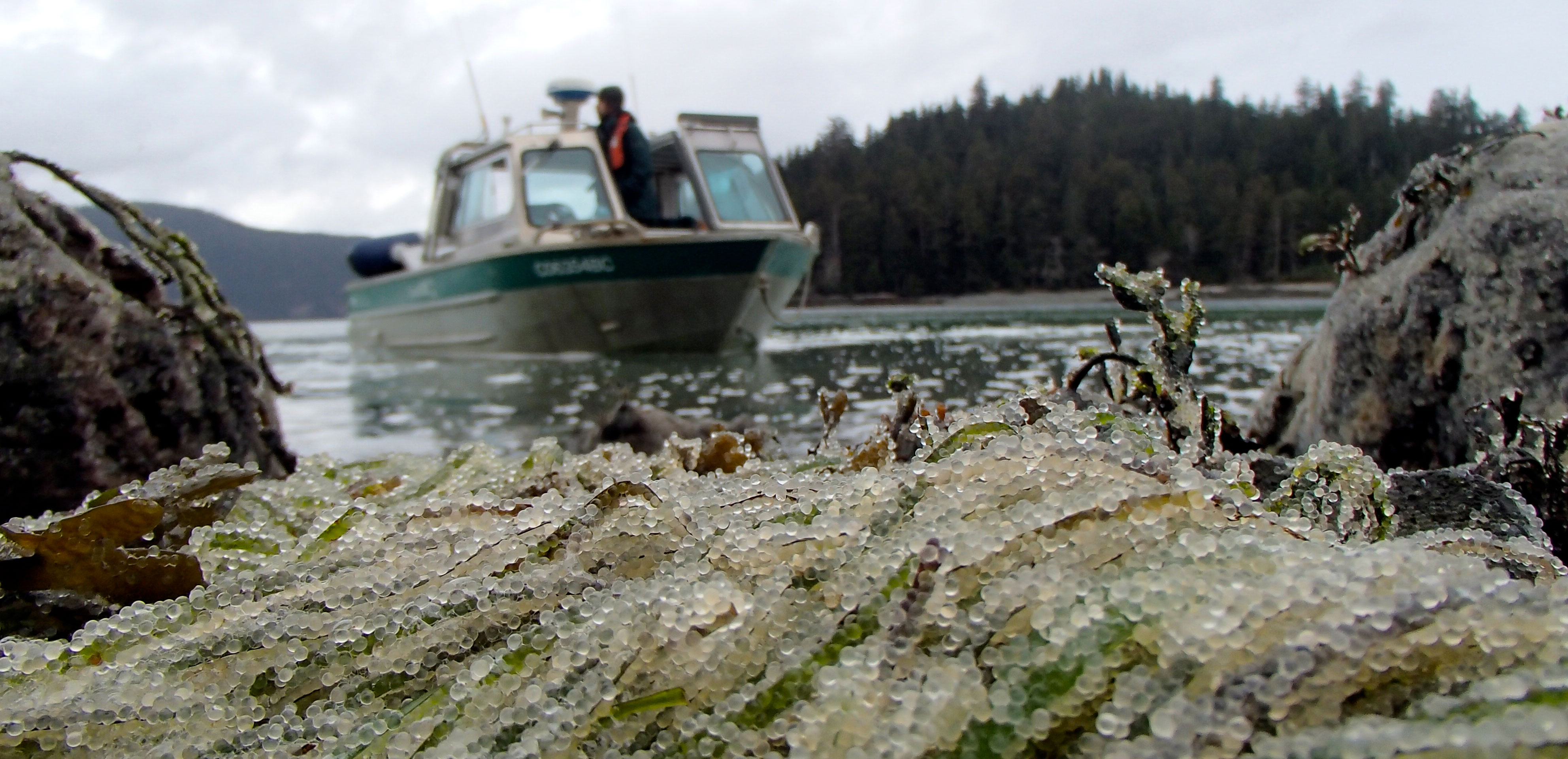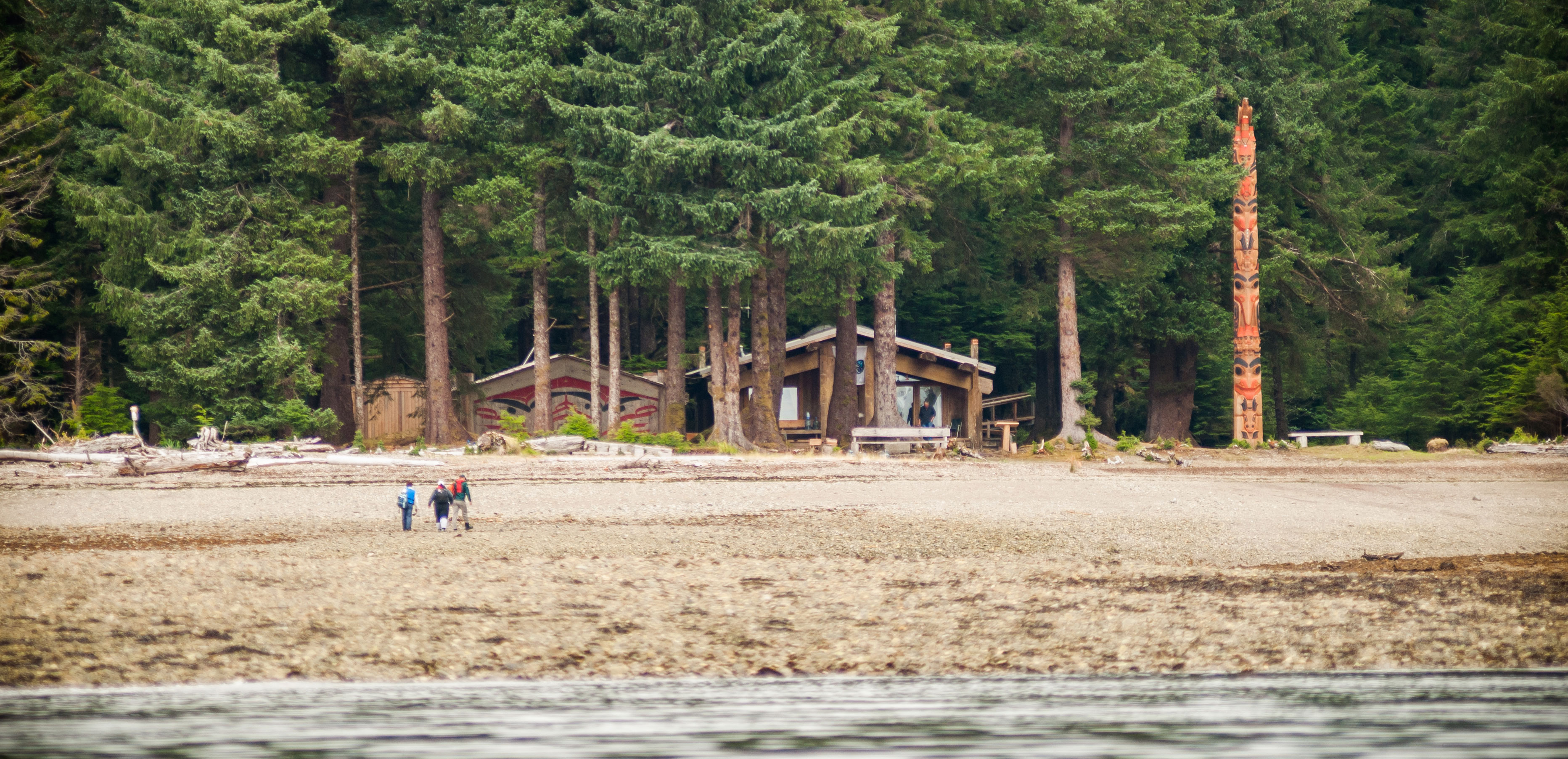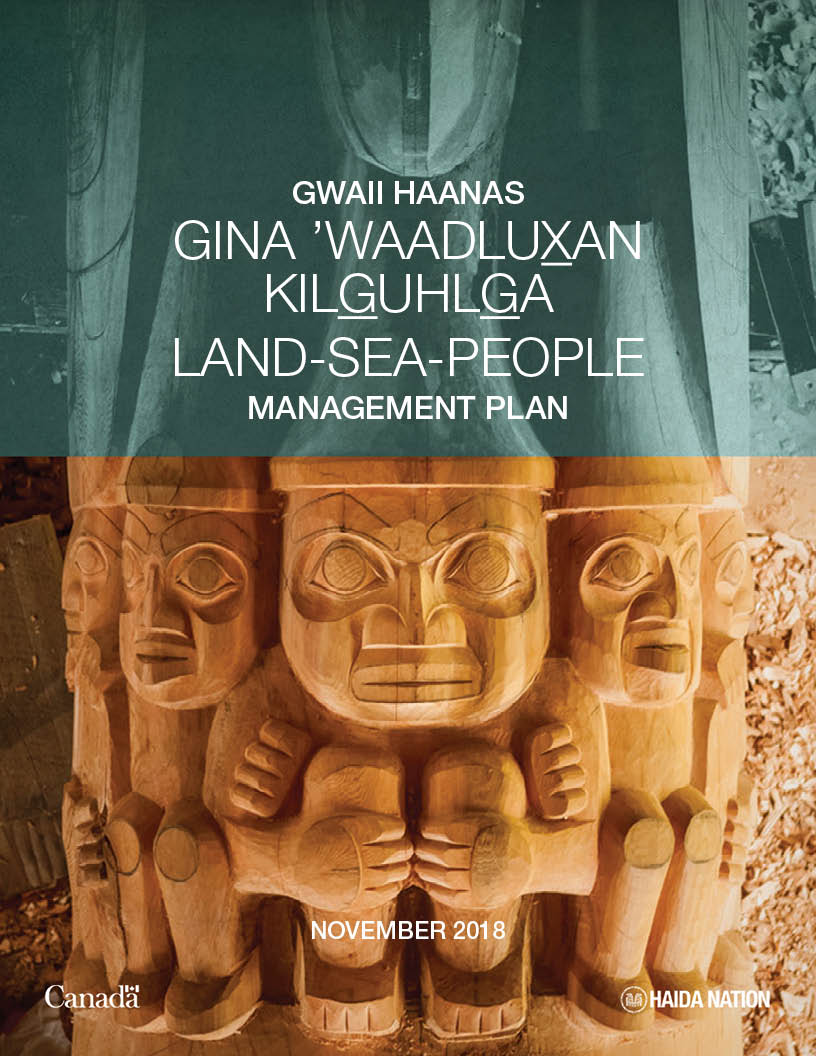
As of May 1, 2019, all commercial and recreational fishing activities will be prohibited within the marine strict protection zones identified in the Gwaii Haanas Gina 'Waadluxan KilGuhlGa Land-Sea-People Management Plan. The new strict protection zones will support cultural and ecological objectives described in the management plan. New zoning also replaces the two Rockfish Conservation Areas in Gwaii Haanas.
See here for details and coordinates:New Gwaii Haanas zoning implemented.
Council of the Haida Nation information
Department of Fisheries and Oceans information
Gwaii Haanas Gina ‘Waadluxan KilGuhlGa Land-Sea-People Management Plan 2018
How to Pronounce Gwaii Haanas Gina ‘Waadluxan KilGuhlGa in Xaayda Kil
Land, sea and people are all interconnected in Gwaii Haanas, so it is only natural that these connections guide how decisions are made. With this in mind, the Gwaii Haanas Archipelago Management Board (AMB) is taking a leadership role by creating the first land-sea-people management plan in Canada. This integrated plan is based on AMB direction and is informed by Haida Nation and Government of Canada priorities. The Gwaii Haanas Land-Sea-People Management Plan provides strategic direction on managing the natural and cultural resources of Gwaii Haanas National Park Reserve, National Marine Conservation Area Reserve, and Haida Heritage Site from mountain top to sea floor, for the next ten years.
Engaging Haida citizens, the Gwaii Haanas Advisory Committee, and key groups including tour operators, fishermen and environmental organizations was an important part of our planning process.
To learn about the Gwaii Haanas Gina 'Waadluxan KilGulGa Land-Sea-People Management Plan and the planning process, click through the tabs below.
First of its kind

A Haida Gwaii Watchmen heads out to meet a group of visitors at Hlk’yah GaawGa Windy Bay, Gwaii Haanas
Parks Canada, Christine Pansino
The Gwaii Haanas Gina 'Waadluxan KilGulGa (Talking about Everything) Land-Sea-People plan is the first management plan of its kind in Canada, if not the world.
Gwaii Haanas is managed cooperatively by the Haida Nation and the Government of Canada (represented by Parks Canada and Fisheries and Oceans Canada) through the Archipelago Management Board (AMB). The six-member team is made up of equal representation from both governments and is guided by the Interim Management Plan for Gwaii Haanas Marine (2010) and the Management Plan for the Terrestrial Area (2003).
The Gwaii Haanas Land-Sea-People Management Plan replaces these plans and includes a single integrated vision and principles to guide the AMB in how they manage this globally renowned protected area. These principles are based in Haida law and include, for example, yahguudang (respect), ‘laa guu ga kanhllns (responsibility), and giid tll’juus (balance). Giid tll’juus requires the AMB to maintain the cultural and ecological richness of Gwaii Haanas while continuing to provide opportunities for those who depend on the area for their livelihood.
What is a management plan?

Haida canoe “LooPlex” is anchored for the night
Parks Canada, Barbara Wojtaszek
A management plan is a guiding document that sets direction and informs decision-making. The objectives and targets in the Land-Sea-People Management Plan will inform Archipelago Management Board (AMB) decision-making and provide direction for Gwaii Haanas staff over the next 10 years.
The Haida Constitution describes the responsibility of Haida citizens to protect and preserve Haida Gwaii’s land, sea and air for future generations. In 1985, the Haida Nation, under Haida law, designated the Gwaii Haanas land and sea area as a Haida Heritage Site. Canada followed with National Park Reserve and National Marine Conservation Area Reserve designations, managed according to the Canada National Parks Act and the Canada National Marine Conservation Areas Act. The AMB is also guided by the Gwaii Haanas Agreement and the Gwaii Haanas Marine Agreement, which require management plans to be developed and reviewed regularly. When both the marine and terrestrial management plans were due for renewal, the AMB decided to integrate them into a single plan, consistent with the original Haida Heritage Site designation.
Key sections in the Land-Sea-People plan include:
- A Vision for the future
- Guiding Principles grounded in Haida law
- Goals, objectives and measureable targets
- A zoning plan driven by key ecological and cultural targets
What is zoning?

The Gwaii Haanas area extends from mountain top, to coast, to approximately 10km offshore
Parks Canada, Stephanie Fung
Zoning is the process of dividing an area of land or water and defining what activities may take place within each area.
The terrestrial area of Gwaii Haanas is managed according to the 2003 terrestrial plan but has not previously been zoned until now. The marine area of Gwaii Haanas was zoned in 2010 when the interim marine plan was signed. In the interim plan, 3% of the Gwaii Haanas marine area was zoned in strict protection, where commercial and recreational fishing and harvesting are prohibited. The AMB recognized that this zoning was modest in scope and committed to the development of a comprehensive zoning plan.
The Gwaii Haanas Land-Sea-People Management Plan includes zoning of both the land and the sea. Zoning is driven by key ecological and cultural targets from the draft Land-Sea-People plan and informed by the best available information, including Haida traditional knowledge.
Engagement
The management planning process was led by the Archipelago Management Board (AMB) and supported by a team of technical staff from Council of the Haida Nation, Parks Canada, and Fisheries and Oceans Canada. The planning team works closely with the Gwaii Haanas Advisory Committee (GHAC).
The GHAC is a group of 13 people with a wide range of knowledge and experience who all share a common interest in Gwaii Haanas. The GHAC has provided advice on all aspects of the Land-Sea-People plan.
Haida citizens were updated and engaged in the planning process through quarterly sessions, the annual Haida Nation House of Assembly, and community meetings. Haida citizens also participated as members of the GHAC and key stakeholder groups, such as tourism and fishing.
Key stakeholders had the opportunity to provide advice at different points in the process. The planning team met with Haida Gwaii municipalities, tour operators, commercial and recreational fishing organizations, marine transportation groups, and environmental non-government organizations.
The full draft management plan was shared for comment at five public events on Haida Gwaii in spring 2018. The draft plan was also shared online and we heard from over 4000 people across Canada.
From coast to coast, we heard that protecting the natural and cultural heritage of Gwaii Haanas is the top priority. Across Haida Gwaii, we also heard how important it is for local people to have affordable ways to visit Gwaii Haanas. These priorities and others are reflected in the new management plan.
Haawa to everyone who provided input to help shape the future of Gwaii Haanas.

Timeline
2014
- Initial goals, objectives and targets drafted
- Gwaii Haanas Advisory Committee (GHAC) established
2015
- GHAC provided advice on draft goals, objectives and targets
- Key stakeholder groups provided advice on draft goals, objectives and targets
- Review of goals, objectives and targets by Council of the Haida Nation, Parks Canada, and Fisheries and Oceans Canada
- Draft goals, objectives and targets revised
2016
- Introductory sections of the management plan drafted
- Zoning methodology developed
- Best available information for zoning collated
- Draft terrestrial zoning proposal developed
- GHAC provided advice on zoning methodology, terrestrial zoning proposal, and data for marine zoning
- Review of introductory sections and revised goals, objectives and targets by Council of the Haida Nation, Parks Canada and Fisheries and Oceans Canada
2017
- Marine spatial data analyses conducted
- Draft marine zoning proposal developed
- Review of draft marine zoning by Council of the Haida Nation, Parks Canada and Fisheries and Oceans Canada
- GHAC provided advice on marine zoning methodology, information and proposal
- Key stakeholders provided advice on marine zoning methodology, information, and proposal
2018
- Key stakeholders provided advice on marine zoning proposal
- Review of full draft Gwaii Haanas Land-Sea-People Management Plan by Council of the Haida Nation, Parks Canada and Fisheries and Oceans Canada
- Public consultation
- Revisions to draft plan
- Final approval, signing and tabling in parliament
FAQs
Why is the Land-Sea-People Management Plan important?
The Land-Sea-People Management Plan is the first of its kind. It describes how the Haida Nation and Government of Canada will steward in Gwaii Haanas, a globally important protected area. It is a rare example of an integrated plan that encompasses a land-and-sea protected area. The Draft Land-Sea-People Management Plan satisfies requirements of the Gwaii Haanas Agreement, the Gwaii Haanas Marine Agreement, the Constitution of the Haida Nation, the National Parks Act, and the National Marine Conservation Areas Act.
Who wrote the Land-Sea-People plan?
The Land-Sea-People plan was developed by the Haida Nation and Government of Canada through the Archipelago Management Board (AMB). The plan incorporates advice from the Gwaii Haanas Advisory Committee, Band Councils, Hereditary Chiefs Council, municipalities, and groups including Haida fisherman, tour operators, commercial fishermen, and environmental organizations. The AMB is supported by a team of technical planners from the Council of the Haida Nation, Parks Canada, and Fisheries and Oceans Canada.
What is an integrated management plan?
An integrated management plan sets direction and informs decision-making for multiple areas or activities that are typically managed separately. Currently, direction for Gwaii Haanas is set out in two different management plans, one for the land and one for the sea. When both management plans were due for renewal, the Archipelago Management Board decided to integrate them into a single plan.
Why is Gwaii Haanas significant?
In 1988, Canada and B.C. signed the South Moresby Agreement, which committed the federal government to create a protected area on the land and sea. The Archipelago Management Board is guided by the 1993 Gwaii Haanas Agreement and the 2010 Gwaii Haanas Marine Agreement. These agreements describe how the Haida Nation and the Government of Canada will manage Gwaii Haanas together. The terrestrial area is a designated National Park Reserve and the marine area was designated a National Marine Conservation Area Reserve in 2010.
Gwaii Haanas is an ecological and cultural treasure. Home to over 700 documented archaeological sites, including tidal and subtidal sites, the record of human occupation dates back over 13,000 years. Ancient Haida villages including SGaang Gwaay, a UNESCO World Heritage Site, showcase world-renowned examples of Haida art and architecture.
Almost 6800 marine and terrestrial species have been documented in Gwaii Haanas, including 42 species at risk. Coastal temperate rainforests and underwater kelp forests support some of the most abundant ecosystems in the world.
Gwaii Haanas is cooperatively managed by the Haida Nation and the Government of Canada through the Archipelago Management Board (AMB). The AMB is made up of three Haida Nation representatives and three Government of Canada representatives (two Parks Canada, one Fisheries and Oceans Canada) and makes decisions via consensus.
Are Haida allowed to harvest on the land and in the strict protection marine zones?
Yes, Haida have the right to continue traditional use throughout Gwaii Haanas consistent with the Constitution of the Haida Nation.
- Date modified :


